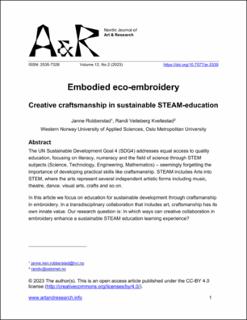| dc.description.abstract | The UN Sustainable Development Goal 4 (SDG4) addresses equal access to quality education, focusing on literacy, numeracy and the science-field STEM subjects (Science, Technology, Engineering, Mathematics), - seemingly forgetting the importance of developing practical skills like craftsmanship. STEAM includes Arts into STEM, where the arts represent several independent artistic forms including music, theater, dance, visual arts, crafts and so on. In this article we focus on education for sustainable development through craftsmanship in embroidery. In a transdisciplinary collaboration that includes art, craftsmanship has its own innate value. Our research question is: In which ways can creative collaboration in embroidery enhance a sustainable STEAM education learning experience? We attempt to find answers to this by looking into how STEAM collaboration may affect the ways we teach craftsmanship, and the challenges and opportunities of doing so in a holistic transdisciplinary project, with a focus on ecological sustainability. Three groups of teacher-students help examine how crafts may contribute in building ecological awareness in themselves and an audience through conveying meaningful artistic narratives. Their embroideries were inspired by the UN’s Decade of Ecosystem Restoration. The results were shared through the Global Science Opera, an international STEAM-education initiative. Our analysis of the research data is influenced by posthumanizing creativity, which emphasizes ethically contributing world citizenship through embodied, collaborative creativity between creator and creation. This journey of making and being made shows a reciprocal relationship between humans and non-humans. The slow-art of embroidery invites the students into an embodied dialogue with the materials, tools, techniques and the scientific topics in the transdisciplinary context. As researchers we wonder how this dialogue and in-depth experience affected the students’ attitudes and actions towards sustainability. We found that the data supports the embodied, co-creative embroidery process, that it improved the students' craft experience, as well as increased the understanding and respect for the challenges in the new eco-reality. | en_US |

